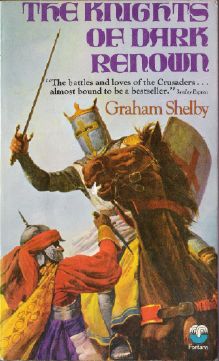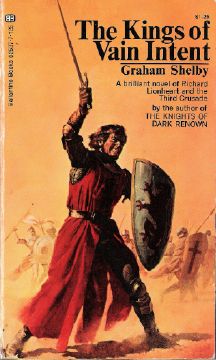The first was not too bad, although its historical perspective (essentially Runciman-derived) has been superseded by more recent research. However, I’m still not convinced by a heterosexual Humphrey de Toron and the soppy teen-romance with Isabella, and the author takes a misogynistic line with Agnes, depicted as a scrawny and unattractive old slapper, who is despised by her lover Eraclius and outlives her son. However, I did like the description of Sibylla as "rabbit-brained".


Graham Shelby, The Knights of Dark Renown & The Kings of Vain Intent
 |
 |
But Kings made me see red…Yes, I know we don’t know much detail about the private lives of most 12C characters, but Shelby’s demonisation of Conrad is appalling and unjustified. A tough adventurer, yes; but a cross between Count Dracula and Cesare Borgia on a bad day, with a sadistic sex-life and a sideline in poisoning?
Marquis Conrad of Montferrat came out of the shadows like an apparition from hell. He was an exceptionally tall man, with narrow shoulders that even now seemed to be held in an invisible vise. He had long, thin fingers, thin wrists and, by the hang of his sleeves, the arms of an undernourished woman. His face was also thin, his cheeks adzed into shadows, his jaw narrow beneath taut skin. His scraped-down features allowed his eyes to register their full impact - hard and wide, then half covered by low, veined lids. Around his face and across his forehead hung lank black hair. It concealed his ears and lay like spilt pitch on his compressed shoulders. It was an unnerving introduction.
It certainly is unnerving, given that the real Conrad was fair and good-looking... (Who is this vampiric impostor?!) Shelby describes him variously as “this sinister Italian”, and “the monster of Montferrat”. (Well, it alliterates!) Shelby implies that he poisoned the Archbishop of Canterbury, and would have poisoned Sibylla if she hadn't died anyway: he literally has a 'hit-list' on his desk! Moreover, he is depicted as a complete stranger: there is no indication that Sybilla's first husband had been his brother, and that his father was still around.
In a sensationalist chapter added especially for the US edition, Shelby depicts him beating and raping his wife:
“…We’ll see if this makes you more amiable." He hefted a black leather belt. The leather was studded with heavy iron stars.
(I won't quote more here, as I try to keep this site as friendly as possible to all ages and sensibilities, but it's quite graphic, nasty, tasteless stuff.)
Needless to say, there is no historical evidence for this depiction. There are no shades of grey to make the portrayal more convincing: this is melodrama villainy, 'Wicked Sir Jasper' stuff, ‘The Perils of Isabella’, solely so that Shelby can propose her as a new murder suspect, and so that the reader will feel no compassion for him when he is mortally wounded. Indeed, Shelby implies that she has ordered the Assassins to inflict as much pain on Conrad as possible without killing him outright. This is just... sick.
From Scott onward, English-language Third Crusade fictions take a kick at Conrad as a "scheming villain". And I forget which romance-writer bizarrely depicts him in passing as a slip of a young thing (he was in his mid-40s) - his cousin-once-removed Philip II's toy-boy!!!! What has he done to deserve any of this?
The real Conrad was a sharp operator at times, but also heroic and shrewd: good 12C king material; player-character material. So why the problem with his reputation?
Richard I. Oc-e-Non. Coeur-de-Lion. Lionheart.
Guy de Lusignan was Richard’s favoured candidate in the protracted contest for the Kingship of Jerusalem. Even when they try to be iconoclastic about Richard himself, English-language writers remain in thrall to parts of his legend, and (perhaps more importantly) his chroniclers’ accounts. Philip of France supported Conrad (as did the polein barons), so he has to be the ‘baddie’…
Then there’s the matter of cultural/ethnic stereotyping. If you are from what’s now Italy, in a historical novel, you must be scheming, sleekit, poisoning, corrupt, sexually kinky… but well-dressed. This is a stereotype from the later Renaissance of Machiavelli, amplified by Italian-set Elizabethan-Jacobean dramas and by Anne Radcliffe's Gothic novels. The 12C Aleramici of Monferrat were an international family, allied with the Holy Roman Empire and with Byzantium, and were cousins of Frederick Barbarossa, Leopold of Austria, Alfonso VII of Castille, and Louis VII. Their court culture was Occitan. Even physically, far from being the swarthy, cadaverous vampire-count Shelby conjures, Conrad resembled the rest of his family: blond, handsome, dashing and dynamic. (I keep picturing Boromir as played by Sean Bean when I think of him!)
It’s lazy to rely on racist clichés instead of research - especially when the real characters have such great dramatic potential for a storyteller. Conrad was assassinated once, by real Assassins; this kind of character-assassination is frankly de trop.
Back to
TOP

